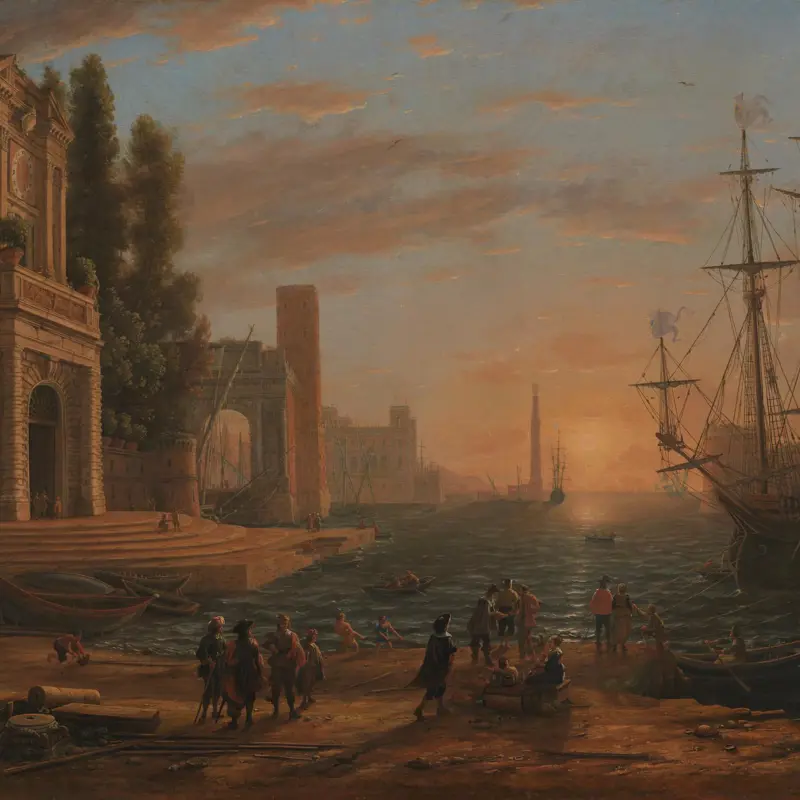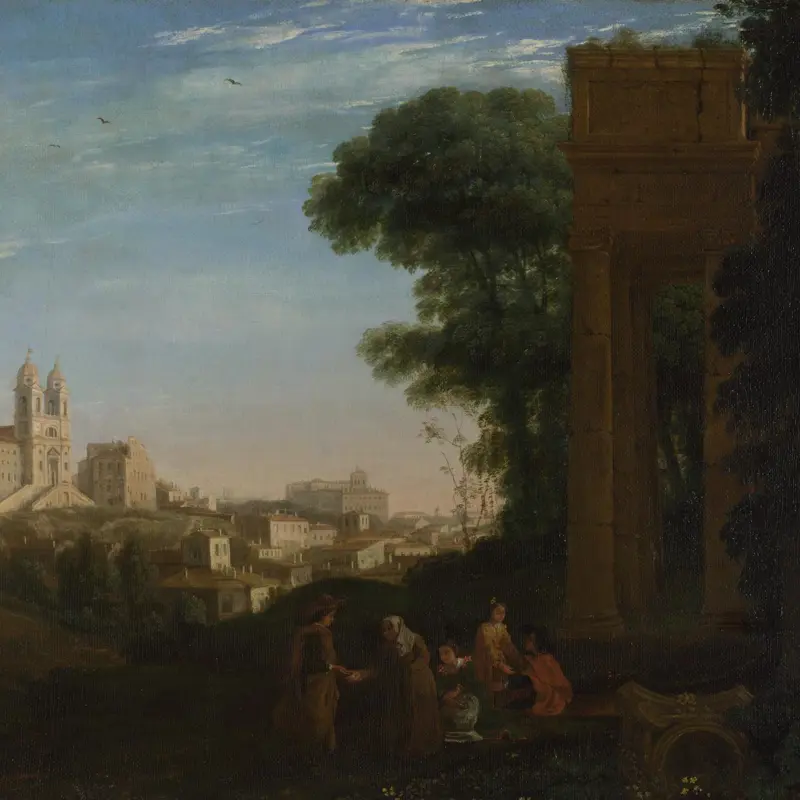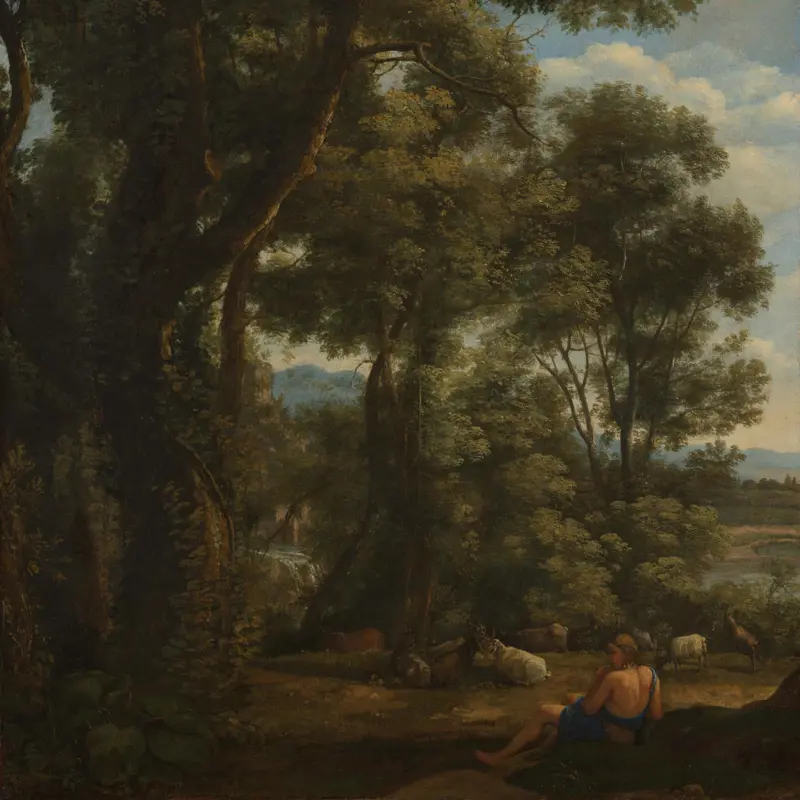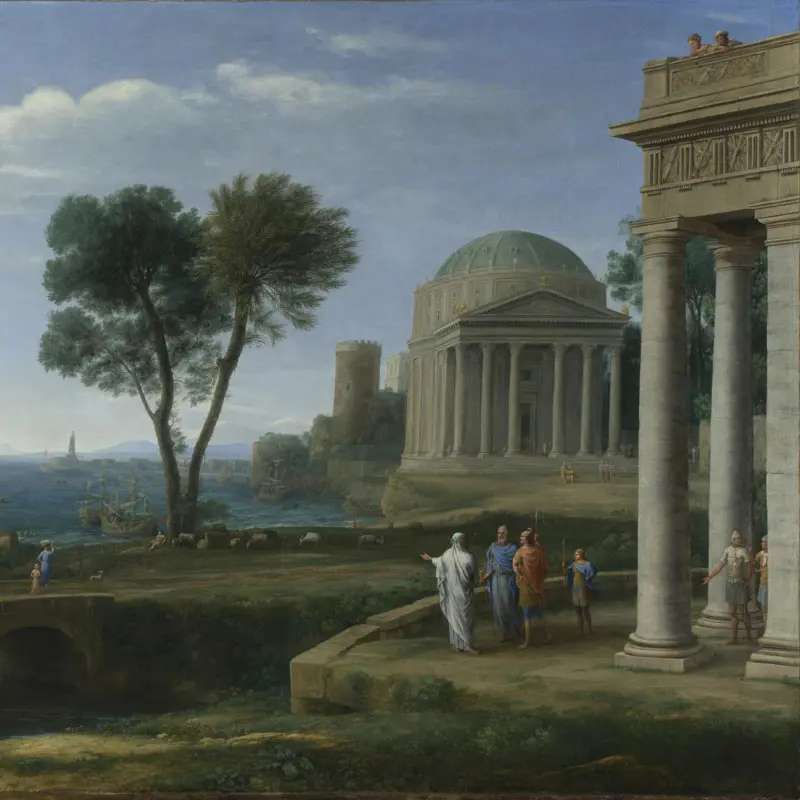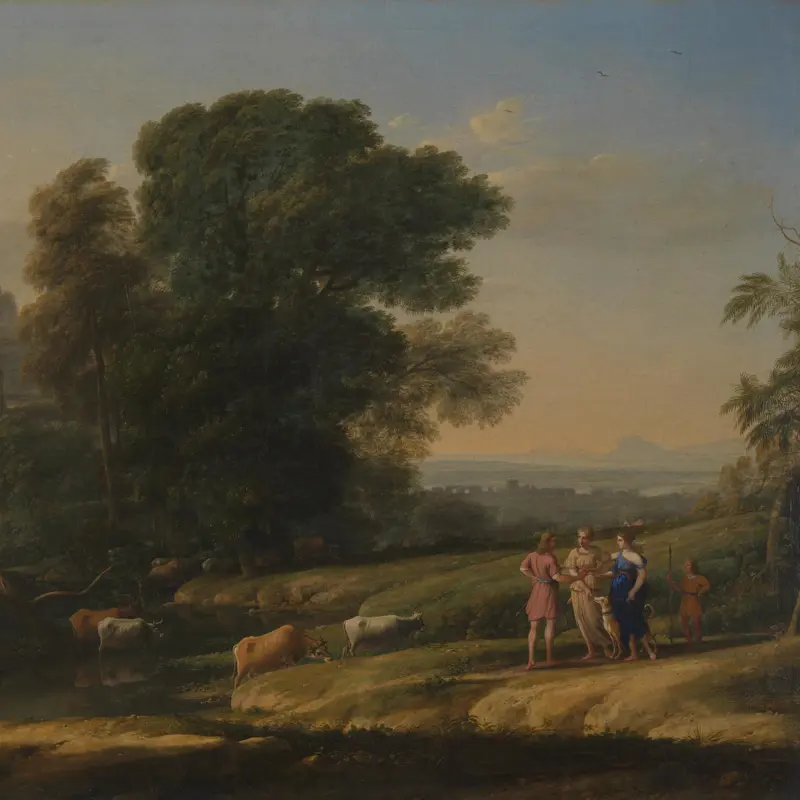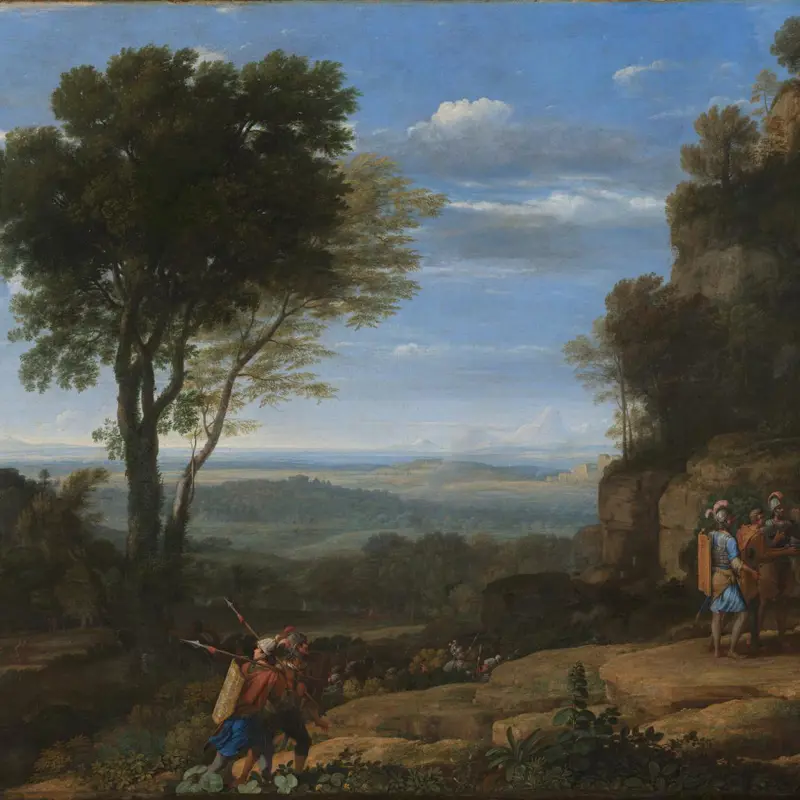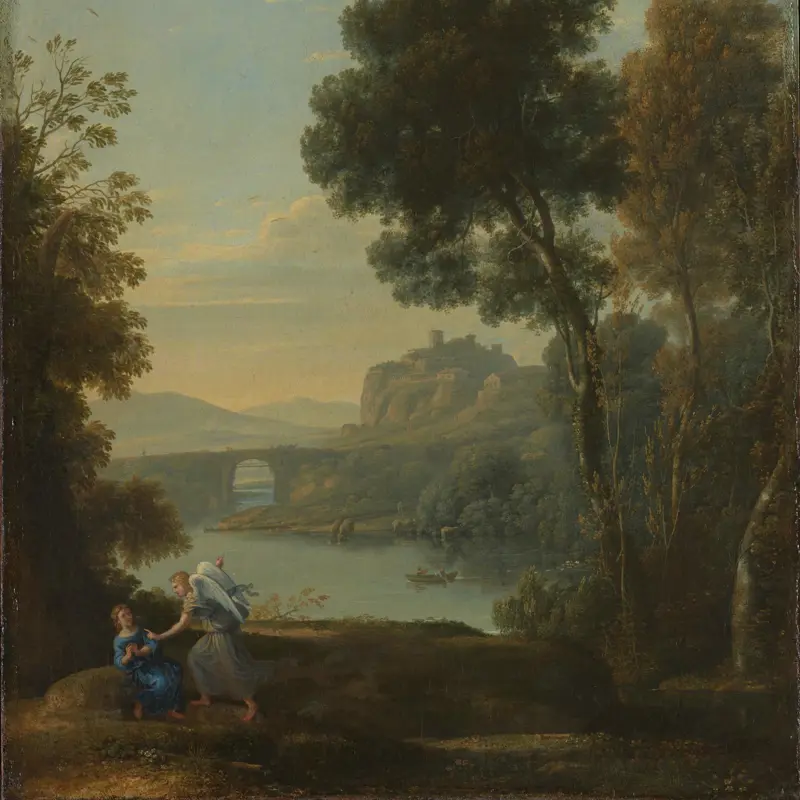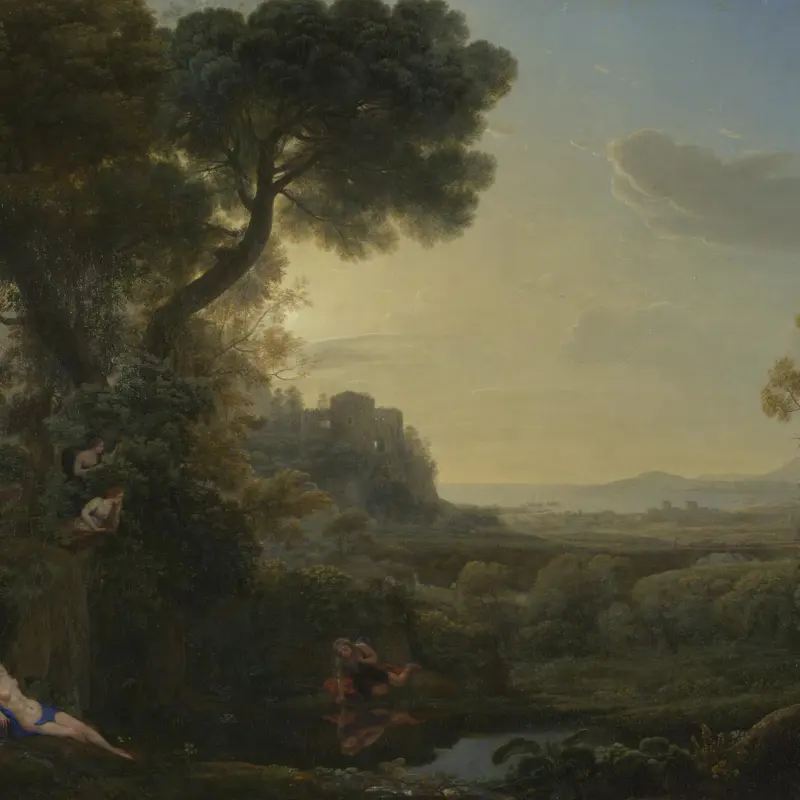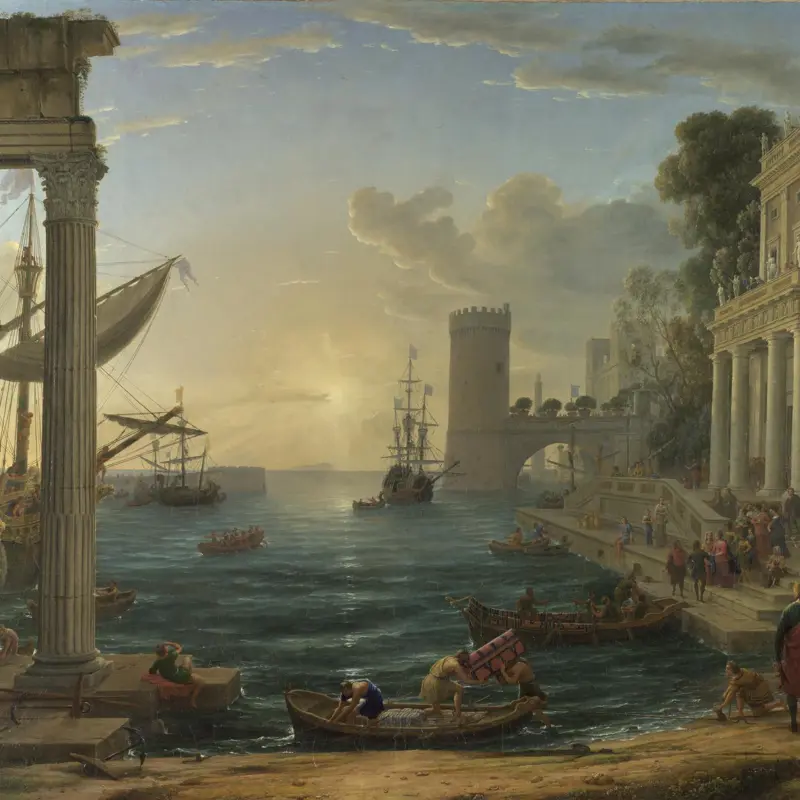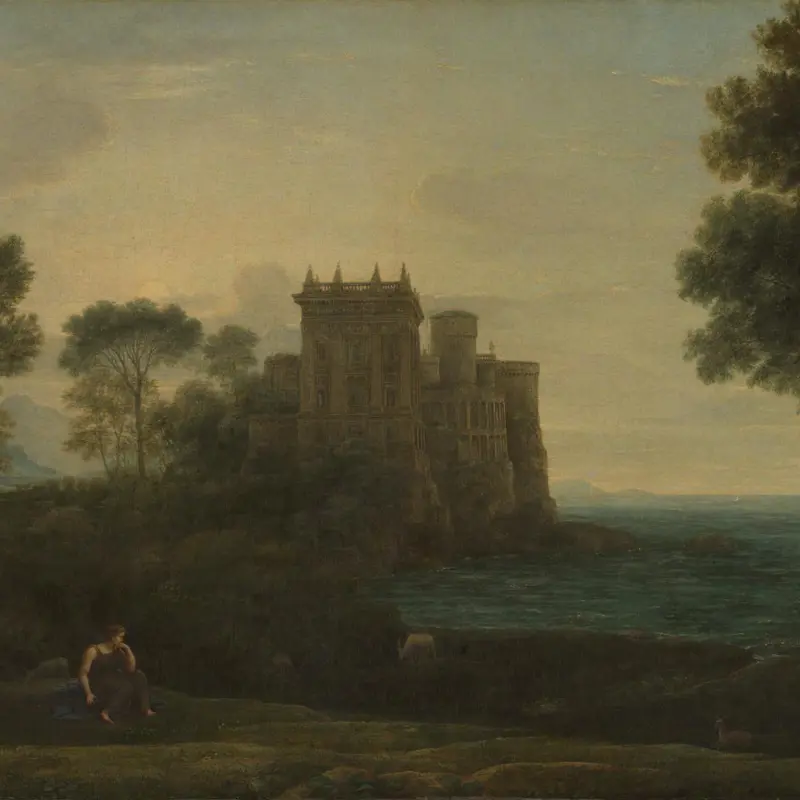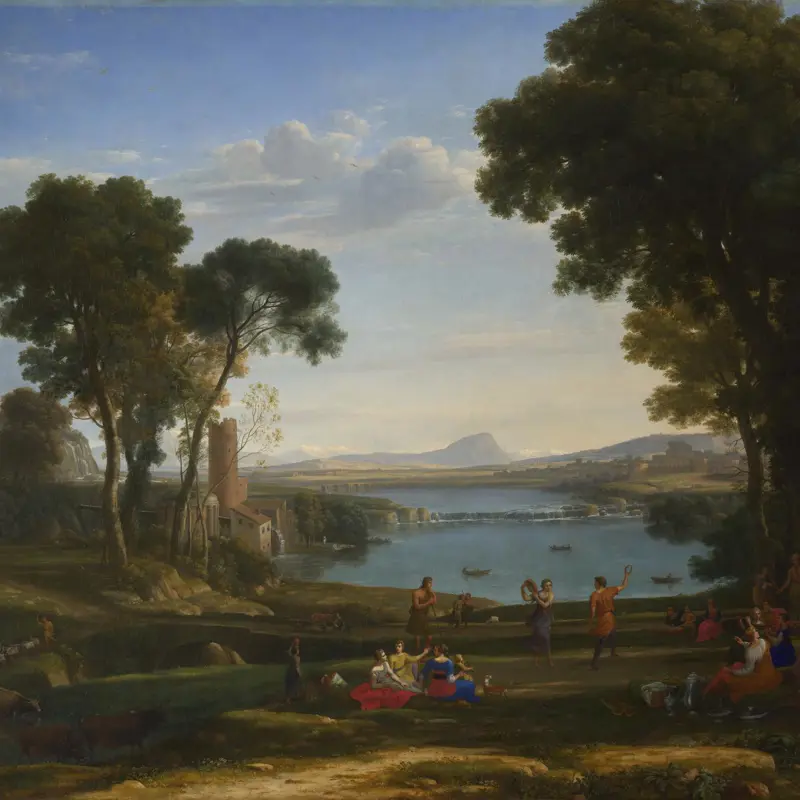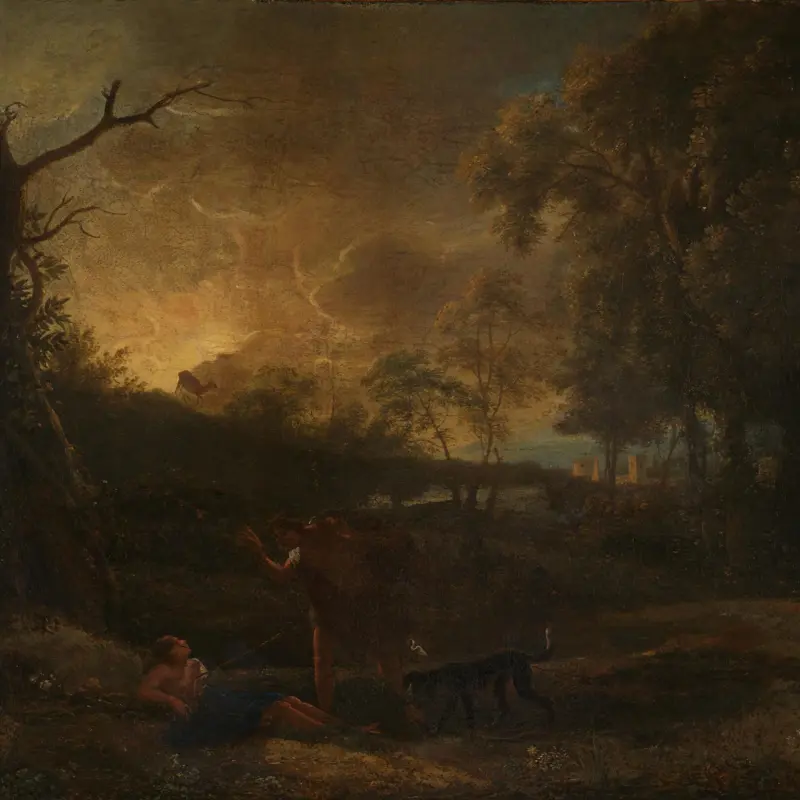Claude, 'Seaport with the Embarkation of Saint Ursula', 1641
About the work
Overview
According to the legend, Saint Ursula, a Christian princess from Britain or Brittany, made a holy pilgrimage to Rome with 11,000 virgins. Dressed in yellow and holding a flag with a red cross, Ursula watches her companions embark on their return voyage. They carry bows and arrows, weapons that represent their death later in the story.
The balance between the soft warmth of the sky and calm sea is typical of Claude’s seascapes. The buildings, trees and ships, all depicted in detail, frame the scene. Claude spent most of his life in Rome: the buildings on the left were inspired by those familiar to him and to this painting’s owner, Fausto Poll (1581–1652), a future cardinal. The palace was inspired by the residence of the powerful Barberini family, Claude’s most influential patrons, whose ship – with their emblem on the flags – is in the centre.
Key facts
Details
- Full title
- Seaport with the Embarkation of Saint Ursula
- Artist
- Claude
- Artist dates
- 1604/5? - 1682
- Date made
- 1641
- Medium and support
- oil on canvas
- Dimensions
- 112.9 × 149 cm
- Inscription summary
- Signed; Dated and inscribed
- Acquisition credit
- Bought, 1824
- Inventory number
- NG30
- Location
- Room 29
- Collection
- Main Collection
- Previous owners
- Frame
- 18th-century French Frame
Provenance
Additional information
Text extracted from the ‘Provenance’ section of the catalogue entry in Humphrey Wine, ‘National Gallery Catalogues: The Seventeenth Century French Paintings’, London 2001; for further information, see the full catalogue entry.
Exhibition history
-
2009Turner and the MastersMuseo Nacional del Prado22 June 2010 - 19 September 2010
-
2018Thomas Cole: Eden to EmpireThe Metropolitan Museum of Art30 January 2018 - 13 May 2018The National Gallery (London)11 June 2018 - 7 October 2018
-
2020Arcadia - A Paradise LostNationalmuseum (Stockholm)24 September 2020 - 17 January 2021
-
2023Masterpieces from the National GalleryShanghai Art Museum East17 January 2023 - 7 May 2023National Museum of Korea2 June 2023 - 9 October 2023Hong Kong Palace Museum22 November 2023 - 11 April 2024Chimei Museum2 May 2024 - 1 September 2024
Bibliography
-
1786125 Pall Mall, A Catalogue of that Truly Superb and Well-Known Collection of Pictures… Property of Monsieur Desenfans… April 8, 1786 and Following Days, London, 8 April 1786
-
1786Christie's, A Catalogue of that Truly Superb and Well-Known Collection of Pictures… Property of Monsieur Desenfans, London, 13 July 1786 - 17 July 1786
-
1786125 Pall Mall, A Catalogue of that Superb, and Well-Known Collections of Pictures: Of the Roman, Venetian, Spanish, French, Flemish, Dutch and English Schools; the Entire and Geniune Property of Monsieur Desenfans, London, 8 April 1786 - 14 April 1786
-
1823J. Young, A Catalogue of the Celebrated Collection of Pictures of the Late John Julius Angerstein, Esq: Containing a Finished Etching of Every Picture, and Accompanied with Historical and Biographical Notices, London 1823
-
1824W. Buchanan, Memoirs of Painting: With a Chronological History of the Importation of Pictures by the Great Masters into England Since the French Revolution, London 1824
-
1829
J. Smith, A Catalogue Raisonné of the Works of the Most Eminent Dutch, Flemish, and French Painters: In Which is Included a Short Biographical Notice of the Artists, with a Copious Description of Their Principal Pictures […], 9 vols, London 1829-1842
-
1884Mme Pattison, Claude Lorrain, sa vie et ses oeuvres, Paris 1884
-
1892A.H. Palmer, The Life and Letters of Samuel Palmer, Painter and Etcher, London 1892
-
1903J. Ruskin, Modern Painters, eds E.T. Cook and A. Wedderburn, The Works of John Ruskin, 39 vols, London 1903
-
1918C. Holmes, 'Notes in the National Gallery, II, the "Tone" of Claude', The Burlington Magazine, XXXIII/184, 1918, pp. 30-5
-
1946Martin Davies, National Gallery Catalogues: French School, London 1946
-
1957Martin Davies, National Gallery Catalogues: French School, 2nd edn (revised), London 1957
-
1961M. Röthlisberger, Claude Lorrain: The Paintings, London 1961
-
1965J. Ziff, 'Copies of Claude's Paintings in the Sketchbooks of J.M.W.Turner', Gazette des beaux-arts, LXV, 1965, pp. 51-64
-
1968M. Röthlisberger, Claude Lorrain: The Drawings, London 1968
-
1969C. Pace, 'Claude the Enchanted: Interpretations of Claude in England in the Earlier Nineteenth Century', The Burlington Magazine, CXLI/1161, 1969, pp. 733-40
-
1969F. Vivian, 'Poussin and Claude Seen from the Archivio Barberini', The Burlington Magazine, CXI/801, 1969, pp. 718-26
-
1970Davies, Martin, and Cecil Gould, National Gallery Catalogues: French School: Early 19th Century, Impressionists, Post-Impressionists etc., London 1970
-
1971J. Sunderl, 'Uvedale Price and the Picturesque', Apollo, 1971, pp. 197-203
-
1972I.G. Kennedy, 'Claude and Architecture', Journal of the Warburg and Courtauld Institutes, XXXV, 1972, pp. 260-83
-
1975M.A. Lavin, Seventeenth-Century Barberini Documents and Inventories of Art, New York 1975
-
1975M. Röthlisberger, L'opera completa di Claude Lorrain, Milan 1975
-
1976D. Cordingly, 'Claude Lorrain and the Southern Seaport Tradition', Apollo, CIII, 1976, pp. 208-13
-
1978A. Macintyre and K. Garlick (eds), The Diary of Joseph Farington, vol. 5, New Haven 1978-1984
-
1978M. Kitson, Claude Lorrain: Liber Veritatis, London 1978
-
1981J. Guillaud et al., Turner en France (exh. cat. Centre Culturel du Marais, 7 October 1981 - 10 January 1982), Paris 1981
-
1982D. Sutton, 'Aspects of British Collecting, II.VII: From Florence to Venice', Apollo, 1982, pp. 390-404
-
1982H.D. Russell, Claude Lorrain 1600-1682 (exh. cat. National Gallery of Art, Washington, 17 October 1982 - 2 February 1983), Washington 1982
-
1982A. Tyndall, Watch this Space: An Exhibition about Perspective in Painting, London 1982
-
1983M. Kitson, 'Turner and Claude', Turner Studies, II/2, 1983, pp. 2-15
-
1984D. Sutton, 'Aspects of British Collecting, III.XII: A Wealth of Pictures', Apollo, CXIX/267, 1984, pp. 346-56
-
1989H. Langdon, Claude Lorrain, Oxford 1989
-
1991L. Bolard, 'La Symbolique des ports chez Claude Lorrain: Une revision', Gazette des beaux-arts, CXVIII, 1991, pp. 221-30
-
1992H. Wine and O. Koester, Fransk Guldalder: Poussin and Claude and French Painting of the Seventeenth Century, (exh. cat. Statens Museum for Kunst, 29 February - 3 May 1992), Copenhagen 1992
-
1994H. Wine, Claude: The Poetic Landscape (exh. cat. The National Gallery, London, 26 January - 10 April 1994), London 1994
-
1996W. Schade, Claude Lorrain: Gemälde und Zeichnungen, Munich 1996
-
1997M.D. Rincón de Arellano, 'Turner visto por sus contemporáneos', Goya, 256, 1997, pp. 235-40
-
1997Sotheby's, An Eighteenth Century Collection of British Prints, London, 13 November 1997
-
1999G. Bergmann, Claude Lorrain: Das Leuchten der Landschaft, München 1999
-
1999C. Stefani, 'Poussin, Lorrain, Dughet e Salvator Rosa: Ricezione e fortuna del paesaggio classico tra Sette e Ottocento', Studi di storia dell'arte, X, 1999, pp. 201-30
-
2000P. Cavazzini, Palazzo Lancellotti ai Coronari: Cantiere di Agostino Tassi, Rome 2000
-
2000M. Kitson, Studies on Claude and Poussin, London 2000
-
2001
C. Baker and T. Henry, The National Gallery: Complete Illustrated Catalogue, London 2001
-
2001H. Wine, National Gallery Catalogues: The Seventeenth Century French Paintings, London 2001
-
2002I. Warrell, Turner et le Lorrain, Paris 2002
-
2004P. Cavazzini, 'Claude's Apprenticeship in Rome: The Market for Copies and the Invention of the Liber Veritatis', Konsthistorisk Tidskrift, LXXIII/3, 2004, pp. 133-46
Frame
This eighteenth-century French frame in the Louis XV style is crafted entirely from oak. The plain swept outlines reveal the back’s gilt lower edge, which is adorned with carved chained cabochons (egg-and-nest). It features delicately carved flower motifs that cascade along the swept outlines. Pierced shell motifs at the centre and corner cartouches have ‘queue de cochon’ (pig’s tail) and ‘rinceau’ (a branch with foliage). The sanded flat transitions into a sight edge decorated with French acanthus leaves. The craftsmanship, particularly the work of the ‘répareur’ who added texture to the backgrounds and intricate details to the leaves, flowers and shells, is characteristic of the Louis XV period.
Acquired sometime after 1935, the frame was meticulously regilded when fitted to Claude’s Seaport with the Embarkation of Saint Ursula.
About this record
If you know more about this work or have spotted an error, please contact us. Please note that exhibition histories are listed from 2009 onwards. Bibliographies may not be complete; more comprehensive information is available in the National Gallery Library.

